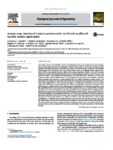Please use this identifier to cite or link to this item:
http://www.alice.cnptia.embrapa.br/alice/handle/doc/1049482| Title: | Annual crop rotation of tropical pastures with no-till soil as affected by lime surface application. |
| Authors: | CRUSCIOL, C. A. C.  MARQUES, R. A.   CARMEIS FILHO, A. C. A.   SORATTO, R. P.   COSTA, C. H. M.   FERRARI NETO, F.   CASTRO, G. S. A.   PARIZ, C. M.   CASTILHOS, A. M DE   |
| Affiliation: | CARLOS A. C. CRUSCIOL, UNESP; RUBIA R. MARQUES, UNESP; ANTÔNIO C. A. CARMEIS FILHO, UNESP; ROGÉRIO P. SORATTO, UNESP; CARLOS H. M. COSTA, UNESP; JAYME FERRARI NETO, UNESP; GUSTAVO SPADOTTI AMARAL CASTRO, CNPM; CRISTIANO M. PARIZ, UNESP; ANDRÉ M. DE CASTILHOS, UNESP. |
| Date Issued: | 2016 |
| Citation: | European Journal of Agronomy, v. 80, p. 88?104, oct. 2016. |
| Description: | Soil acidity and low natural fertility are the main limiting factors for grain production in tropical regionssuch as the Brazilian Cerrado. The application of lime to the surface of no-till soil can improve plant nutrition, dry matter production, crop yields and revenue. The present study, conducted at the Lageado Experimental Farm in Botucatu, State of São Paulo, Brazil, is part of an ongoing research project initi-ated in 2002 to evaluate the long-term effects of the surface application of lime on the soil?s chemical attributes, nutrition and kernel/grain yield of peanut (Arachis hypogaea), white oat (Avena sativa L.) and maize (Zea mays L.) inter cropped with palisade grass (Urochloa brizantha cv. Marandu), as well as the forage dry matter yield of palisade grass in winter/spring, its crude protein concentration, estimated meat production, and revenue in a tropical region with a dry winter during four growing seasons. The experiment was designed in randomized blocks with four replications. The treatments consisted of four rates of lime application (0, 1000, 2000 and 4000 kg ha−1), performed in November 2004. The surface application of limestone to the studied tropical no-till soil was efficient in reducing soil acidity from the surface down to a depth of 0.60 m and resulted in greater availability of P and K at the soil surface. Ca and Mg availability in the soil also increased with the lime application rate, up to a depth of 0.60 m. Nutrient absorption was enhanced with liming, especially regarding the nutrient uptake of K, Ca and Mg by plants.Significant increases in the yield components and kernel/grain yields of peanut, white oat and maize were obtained through the surface application of limestone. The lime rates estimated to achieve the maximum grain yield, especially in white oat and maize, were very close to the rates necessary to increase the base saturation of a soil sample collected at a depth of 0?0.20 m to 70%, indicating that the surface liming of 2000 kg ha−1is effective for the studied tropical no-till soil. This lime rate also increases the forage dry matter yield, crude protein concentration and estimated meat production during winter/spring in the maize-palisade grass inter cropping, provides the highest total and mean net profit during the four growing seasons, and can improve the long-term sustainability of tropical agriculture in the Brazilian Cerrado. |
| NAL Thesaurus: | Acidity Soil management Plant nutrition |
| Keywords: | Sustainability of tropical agriculture Net profit |
| ISBN: | 1161-0301 |
| DOI: | http://dx.doi.org/10.1016/j.eja.2016.07.002 |
| Type of Material: | Artigo de periódico |
| Access: | openAccess |
| Appears in Collections: | Artigo em periódico indexado (CNPM)  |










